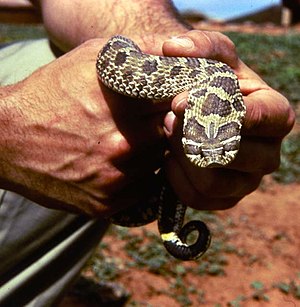Western hook-nosed snake
| Western hook-nosed snake | ||||||||||||
|---|---|---|---|---|---|---|---|---|---|---|---|---|

Western hook-nosed snake ( Heterodon nasicus ) |
||||||||||||
| Systematics | ||||||||||||
|
||||||||||||
| Scientific name | ||||||||||||
| Heterodon nasicus | ||||||||||||
| Baird & Girard , 1852 |
The Western hooked nose snake ( Heterodon nasicus ), and Western Hook Snake is a snake from the family of snakes (Colubridae), where it to the subfamily of xenodontinae is provided. Their distribution area is in North America and in northern Mexico .
The two earlier subspecies H. n. Gloydi and H. n. Kennerlyi are now listed within the genus as separate species Heterodon gloydi and Heterodon kennerlyi .
description
Hooked-nosed snakes usually reach a body length of 45–60 cm, maximum 90 cm. There is a pronounced sexual dimorphism ; the females are larger and much heavier than the males. Both sexes live to be 15 to 18 years old in captivity. Their mating season is in spring between March and May.
The western hook-nosed snake is diurnal. It gets its name from its hook-shaped or snout-shaped modified Scutum rostrale , which helps it dig.
Heterodon nasicus has furrowed ( opistoglyph ) fangs in the back of the upper jaw. As a rule, however, this snake does not pose any danger to humans. Their poison, which is one of the salivary toxins, would have to be massaged in over a long period of time in order to develop its effect on humans. The toxic effect is negligible in healthy, adult people, but caution is advisable in allergy sufferers. Overall, humans are very rarely bitten. It is believed that the venom from the hook-nosed snake has neurotoxic effects on amphibians . The enlarged teeth are probably used to "pierce" toads or frogs, which often inflate themselves in defense. They represent the main prey animals and the eating process is greatly simplified.
Defensive behavior
Hook-nosed snakes have impressive defensive behavior. If she feels threatened, she first spreads her neck, which is bent into an S shape to strike. Thanks to the pattern on its body, it resembles a subspecies of the western dwarf rattlesnake ( Sistrurus miliarus streckeri ), which occurs in the same range (Bates' mimicry ). In addition, sham attacks are carried out with the mouth closed. If an attacker is not impressed, she turns on her back and lets a foul-smelling, milky white liquid escape through her anal scutum . It can also bleed from the mouth through deliberate rupture of smaller blood vessels. By killing it, it confuses predators and presents itself as inedible.
literature
- M. Hoffmann: Manual snake care. BEDE-Verlag, 2006, ISBN 3-89860-135-8 .
- C. Mattison: Snake. Firefly Books, 1999, ISBN 1-55209-415-4 .
- AD Richardson: Hognose Snakes. Capstone Press, 1966, ISBN 0-7368-2136-8 .
- T. Schmidt: The western hook-nosed snake. Natur und Tier Verlag, 2009, ISBN 978-3-86659-120-2 .
Individual evidence
Web links
- Heterodon nasicus in The Reptile Database
- Heterodon nasicus inthe IUCN 2013 Red List of Threatened Species . Listed by: Hammerson, GA, 2007. Retrieved September 4, 2013.

